The name "Shim'on" appears on all of the coins of the Second Revolt except for a few types issued at the beginning of the revolt with the name "Eleazar the Priest (Cohen)," who may have been Bar Kochba's uncle. (#96, 97)

#96 Eleazar the Priest, silver zuz 132/133 CE (H-1374 )
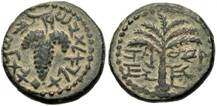
#97 Eleazar the Priest, small bronze 132/133 CE (H-1388 )
Unlike the situation at the start of the First Revolt, in Bar Kochba's time there was no Temple and no Temple Treasury. So, in order to mint their own coins as a sign of sovereignty, they gathered all of the bronze and silver foreign (Rome, Syria, Phoenicia, etc.) coins circulating in Judaea. Then they filed off the original designs and restamped them with Jewish symbols and Hebrew inscriptions relating to their hope of rebuilding the Temple. Many coins exhibit parts of the original designs and legends. Coins of the first two years are dated Year 1 and Year 2 "of the Freedom (or Redemption) of Israel (or Jerusalem)." But in the third year, when the revolt became more of a defensive guerrilla action, the inscription changed to the hope "For the Freedom of Jerusalem."
The overstruck silver tetradrachms (called "sela" in the Mishnah) are among the most religiously significant coins issued by the ancient Jews, since the Holy of Holies of the Jerusalem Temple is depicted, along with the Ark - that had held the two tablets of the Ten Commandments in Solomon's time. "Jerusalem" was inscribed around the Temple. (#98) Beginning in the second year (#99) and continuing into the final year (#100), a star appeared above the Temple on many coins, likely alluding to Bar Kochba's nickname "Son of the Star." And some of these large silver coins issued in the third year of the revolt feature a wavy line above the Temple, perhaps representing an ornamental grape vine. (#101)
Agricultural symbols associated with the harvest festival of Succoth - lulav and etrog - appear on the reverse, surrounded by a Hebrew inscription: "Year One of the Redemption of Israel," "Year Two of the Freedom of Israel," or "For the Freedom of Jerusalem," respectively in the three years of the revolt. In a letter from Bar Kochba, discovered in the late 1950s, the Jewish leader orders Judah Ben Manasseh to supply him with lulav for his army so that they could celebrate the festival even though they were in the midst of major battles.

#98 Bar Kochba, silver sela 132/133 CE (H-1373 )

#99 Bar Kochba, silver sela 133/134 CE (H-1388 )

#100 Bar Kochba, silver sela 134/135 CE (H-1411 )

#101 Bar Kochba, silver sela 134/135 CE (H-1413 )
There are dozens of varieties of overstruck Roman silver denarii (called "zuz" in Hebrew). There are some very rare Year 1 zuzim inscribed Eleazar the Priest instead of Shim'on. (#96) Otherwise, most have an abbreviated form of Bar Kochba's first name "Shim’o'" or the full name "Shim'on" within a wreath on one side, and the date (Year 1 or 2) or "For the Freedom of Jerusalem" (Year 3) on the reverse. The symbols are associated with the Temple - palm branch, amphora, bunch of grapes, lyre and trumpets. (#103, 104, 105)

#103 Bar Kochba, silver zuz, Shim'o & trumpets 133/134 CE (H-1392 )

#104 Bar Kochba, silver zuz, Shim'on & palm branch 134/135 CE (H-1420)

#105 Bar Kochba, silver zuz, grapes & wide lyre 133/134 CE (H-1393 )
The rarest of all Bar Kochba denominations is the large (28-35mm.) bronze, overstruck (and usually weak, with parts of the design or inscription indistinct) on a Roman sestertius. The large size allowed the engravers to inscribe the full name of "Shim'on Prince (Nasi) of Israel" within a wreath. The reverse features an amphora, which Romanoff concludes "was the vessel of oil which nourished the flames of the Temple Menorah (7-branched candelabrum)."
A file was used to remove the designs of the underlying coins, such as the portrait of the Roman Emperor, and this is readily apparent on some of the large bronzes. (#106) In rare instances, the coin cracked when it was overstruck. (#107)

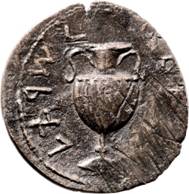
#106 Bar Kochba, large bronze, Shim'on & amphora 133/134 CE (H-1405 )
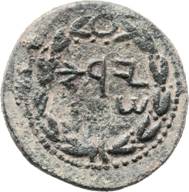

#107 Bar Kochba, large bronze, Jerusalem & amphora 133/134 CE (H-1404 )
The 24-26mm. bronzes of Bar Kochba picture a grape vine leaf and 7-branched palm tree. The seven branches of the palm tree could well allude to the holy 7-branched Temple Menorah, that was considered too holy to depict on coins (with the isolated exception of the small bronze Menorah coin issued in the last desperate days of the reign of Antigonus Mattathias). Bar Kochba's given name appears on the palm tree side either in full with his title: Shim'on the Prince of Israel (#108), or without the title: Shim'on (#109), or shortened as Shim' (#110).

#108 Bar Kochba, 24-26mm. middle bronze, 132/133 CE (H-1378 )

#109 Bar Kochba, 24-26mm. middle bronze, 133/134 CE (H-1408a )

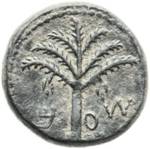
#110 Bar Kochba, 24-26mm. middle bronze, 133/134 CE (H-1408 )
The 20-24mm. bronzes of Bar Kochba feature an upright palm branch within a wreath, and a lyre. The lyre is either a wide 4-6 stringed chelys type (#111) or narrow 3 stringed kithara (#112). The Jewish leader's name and title surround the wreath: "Shim'on Prince of Israel," while a patriotic (and religiously significant motto is inscribed on the reverse, such as "Year One of the Redemption of Israel," "Year Two of the Freedom of Jerusalem," or "For the Freedom of Jerusalem."
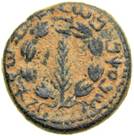
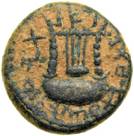
#111 Bar Kochba, 20-24mm. middle bronze, 132/133 CE (H-1377 )
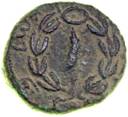

#112 Bar Kochba, 20-24mm. middle bronze, 134/135 CE (H-1436 )
The smallest (18-21mm.) bronze coins issued during the Second Revolt all picture a bunch of grapes, and a 7-branched palm tree with clusters of dates. The legends surrounding the grapes are similar to other issues: "Year One of the Redemption of Israel," "Year Two of the Freedom of Jerusalem," "For the Freedom of Jerusalem," etc. The inscription around the palm tree begins in the first year with "Eleazar the Priest" (#97) and changes to "Jerusalem" (#114), which continues through the second year, and finally changes to "Shim'on" in the third year of the revolt (#115).
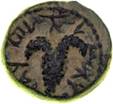

#114 Bar Kochba, 18-21mm. Small bronze, "Jerusalem" 133/134 CE (H-1410 )
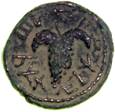
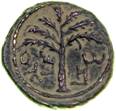
#115 Bar Kochba, 18-21mm. Small bronze, "Shim'on" 134/135 CE (H-1440 )
It is estimated that over half a million Jews fell in battle during the Second Revolt, with countless more sold as slaves after the final defeat of Bar Kochba at Betar. The Romans too suffered such heavy losses that when Hadrian sent a written report of the campaign to the senate, he omitted the usual introductory remarks that the emperor and the army were well.
© 2020-Mel Wacks